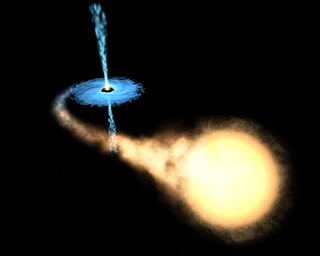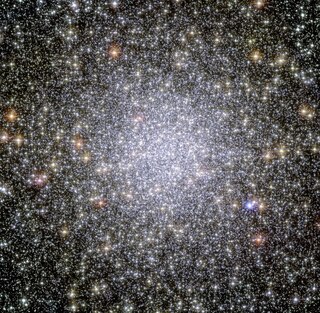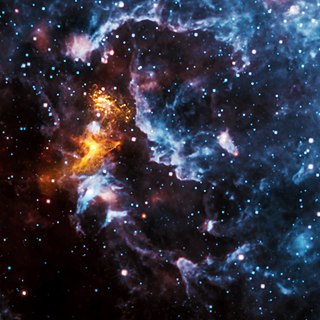
A neutron star is the collapsed core of a massive supergiant star, which had a total mass of between 10 and 25 solar masses (M☉), possibly more if the star was especially metal-rich. Except for black holes, neutron stars are the smallest and densest currently-known class of stellar objects. Neutron stars have a radius on the order of 10 kilometres (6 mi) and a mass of about 1.4 M☉. They result from the supernova explosion of a massive star, combined with gravitational collapse, that compresses the core past white dwarf star density to that of atomic nuclei.
Timeline of neutron stars, pulsars, supernovae, and white dwarfs

X-ray binaries are a class of binary stars that are luminous in X-rays. The X-rays are produced by matter falling from one component, called the donor, to the other component, called the accretor, which is very compact: a neutron star or black hole. The infalling matter releases gravitational potential energy, up to several tenths of its rest mass, as X-rays. The lifetime and the mass-transfer rate in an X-ray binary depends on the evolutionary status of the donor star, the mass ratio between the stellar components, and their orbital separation.

Russell Alan Hulse is an American physicist and winner of the Nobel Prize in Physics, shared with his thesis advisor Joseph Hooton Taylor Jr., "for the discovery of a new type of pulsar, a discovery that has opened up new possibilities for the study of gravitation".
X-ray pulsars or accretion-powered pulsars are a class of astronomical objects that are X-ray sources displaying strict periodic variations in X-ray intensity. The X-ray periods range from as little as a fraction of a second to as much as several minutes.

47 Tucanae or 47 Tuc is a globular cluster located in the constellation Tucana. It is about 4.45 ± 0.01 kpc (15,000 ± 33 ly) away from Earth, and 120 light years in diameter. 47 Tuc can be seen with the naked eye, with an apparent magnitude of 4.1. It appears about 44 arcminutes across including its far outreaches. Due to its far southern location, 18° from the south celestial pole, it was not catalogued by European astronomers until the 1750s, when the cluster was first identified by Nicolas-Louis de Lacaille from South Africa.

A pulsar is a highly magnetized rotating neutron star that emits beams of electromagnetic radiation out of its magnetic poles. This radiation can be observed only when a beam of emission is pointing toward Earth, and is responsible for the pulsed appearance of emission. Neutron stars are very dense and have short, regular rotational periods. This produces a very precise interval between pulses that ranges from milliseconds to seconds for an individual pulsar. Pulsars are one of the candidates for the source of ultra-high-energy cosmic rays.

A millisecond pulsar (MSP) is a pulsar with a rotational period less than about 10 milliseconds. Millisecond pulsars have been detected in radio, X-ray, and gamma ray portions of the electromagnetic spectrum. The leading theory for the origin of millisecond pulsars is that they are old, rapidly rotating neutron stars that have been spun up or "recycled" through accretion of matter from a companion star in a close binary system. For this reason, millisecond pulsars are sometimes called recycled pulsars.

A transient X-ray source first discovered in 1996 by the Italian-Dutch BeppoSAX satellite, SAX J1808.4−3658 revealed X-ray pulsations at the 401 Hz neutron star spin frequency when it was observed during a subsequent outburst in 1998 by NASA's RXTE satellite. The neutron star is orbited by a brown dwarf binary companion with a likely mass of 0.05 solar masses, every 2.01 hours. X-ray burst oscillations and quasi-periodic oscillations in addition to coherent X-ray pulsations have been seen from SAX J1808.4-3658, making it a Rosetta stone for interpretation of the timing behavior of low-mass X-ray binaries.

Walter Hendrik Gustav Lewin is a Dutch astrophysicist and retired professor of physics at the Massachusetts Institute of Technology. Lewin earned his doctorate in nuclear physics in 1965 at the Delft University of Technology and was a member of MIT's physics faculty for 43 years beginning in 1966 until his retirement in 2009.
The Bruno Rossi Prize is awarded annually by the High Energy Astrophysics division of the American Astronomical Society "for a significant contribution to High Energy Astrophysics, with particular emphasis on recent, original work". Named after astrophysicist Bruno Rossi, the prize is awarded with a certificate and a gift of USD $500, and was first awarded in 1985 to William R. Forman and Christine Jones Forman "for pioneering work in the study of X-ray emission from early type galaxies". It has been awarded 32 times. In 2010, the prize was awarded to William B. Atwood, Peter Michelson and the Fermi Gamma-ray Space Telescope team "for enabling, through the development of the Large Area Telescope, new insights into neutron stars, supernova remnants, cosmic rays, binary systems, active galactic nuclei, and gamma-ray bursts". In 2013, the prize was awarded to Roger W. Romani of Leland Stanford Junior University and Alice Harding of Goddard Space Flight Center for their work in developing the theoretical framework underpinning the many exciting pulsar results from Fermi Gamma-ray Space Telescope.

Shrinivas Ramchandra Kulkarni is a US-based astronomer born and raised in India. He is currently a professor of astronomy and planetary science at California Institute of Technology, and he served as director of Caltech Optical Observatory (COO) at California Institute of Technology, in which capacity he oversaw the Palomar and Keck among other telescopes. He is the recipient of a number of awards and honours.
In X-ray astronomy, quasi-periodic oscillation (QPO) is the manner in which the X-ray light from an astronomical object flickers about certain frequencies. In these situations, the X-rays are emitted near the inner edge of an accretion disk in which gas swirls onto a compact object such as a white dwarf, neutron star, or black hole.

The Spinoza Prize is an annual award of 2.5 million euro prize money, to be spent on new research given by the Dutch Research Council (NWO). The award is the highest scientific award in the Netherlands. It is named after the philosopher Baruch de Spinoza.

Edward Peter Jacobus (Ed) van den Heuvel is a Dutch astronomer and emeritus professor at the Astronomical Institute Anton Pannekoek of the University of Amsterdam.

The Black Widow Pulsar is an eclipsing binary millisecond pulsar in the Milky Way. Discovered in 1988, it is located roughly 6,500 light-years away from Earth. It orbits with a brown dwarf or Super-Jupiter companion with a period of 9.2 hours with an eclipse duration of approximately 20 minutes. When it was discovered, it was the first such pulsar known. The prevailing theoretical explanation for the system implied that the companion is being destroyed by the strong powerful outflows, or winds, of high-energy particles caused by the neutron star; thus, the sobriquet black widow was applied to the object. Subsequent to this, other objects with similar features have been discovered, and the name has been applied to the class of millisecond pulsars with an ablating companion, as of February 2023 around 41 black widows are know to exist.

PSR J1311–3430 is a pulsar with a spin period of 2.5 milliseconds. It is the first millisecond pulsar found via gamma-ray pulsations. The source was originally identified by the Energetic Gamma Ray Experiment Telescope as a bright gamma ray source, but was not recognized as a pulsar until observations with the Fermi Gamma-ray Space Telescope discovered pulsed gamma ray emission. The pulsar has a helium-dominated companion much less massive than itself, and the two are in an orbit with a period of 93.8 minutes. The system is explained by a model where mass from the low mass companion was transferred on to the pulsar, increasing the mass of the pulsar and decreasing its period. These systems are known as Black Widow Pulsars, named after the original such system discovered, PSR B1957+20, and may eventually lead to the companion being completely vaporized. Among systems like these, the orbital period of PSR J1311–3430 is the shortest ever found. Spectroscopic observations of the companion suggest that the mass of the pulsar is 2.7 . Though there is considerable uncertainty in this estimate, the minimum mass for the pulsar that the authors find adequately fits the data is 2.15 , which is still more massive than PSR J1614−2230, the previous record holder for most massive known pulsar.

George Albert Sawatzky is a Canadian physicist, known for his research in solid state physics and strongly correlated electron systems. He has co-developed the Cini-Sawatzky theory of the Auger effect and the ZSA (Zaanen-Sawatzky-Allen) classification of bandgaps in solids.

Marileen Dogterom is a Dutch biophysicist and professor at the Kavli Institute of Nanoscience at Delft University of Technology. She published in Science, Cell, and Nature and is notable for her research of the cell cytoskeleton. For this research, she was awarded the 2018 Spinoza Prize.
Rudy Wijnands is a Dutch astrophysicist. He is professor of Observational High-Energy Astrophysics at the University of Amsterdam.















